Auditing Report: Ethical and Legal Liability Analysis for MYH
VerifiedAdded on 2020/02/19
|11
|2562
|86
Report
AI Summary
This report delves into the ethical and legal considerations within the auditing profession, specifically analyzing the case of MYH and its associated liabilities. It begins by examining the ethical decision-making process, utilizing the American Accounting Association (AAA) model to address potential conflicts of interest and responsibilities. The report then explores the legal liabilities of auditors, particularly concerning third-party reliance on audited financial statements. It discusses the application of three key tests: special relationship, reasonable foreseeability, and current proximity, to determine an auditor's liability in negligence cases. The report also analyzes a specific scenario involving the Scott Group and MYH, highlighting the importance of ethical conduct and the potential consequences of negligence in auditing practices. The report concludes with a summary of the ethical and legal implications that auditors must consider to maintain integrity and fulfill their professional duties.
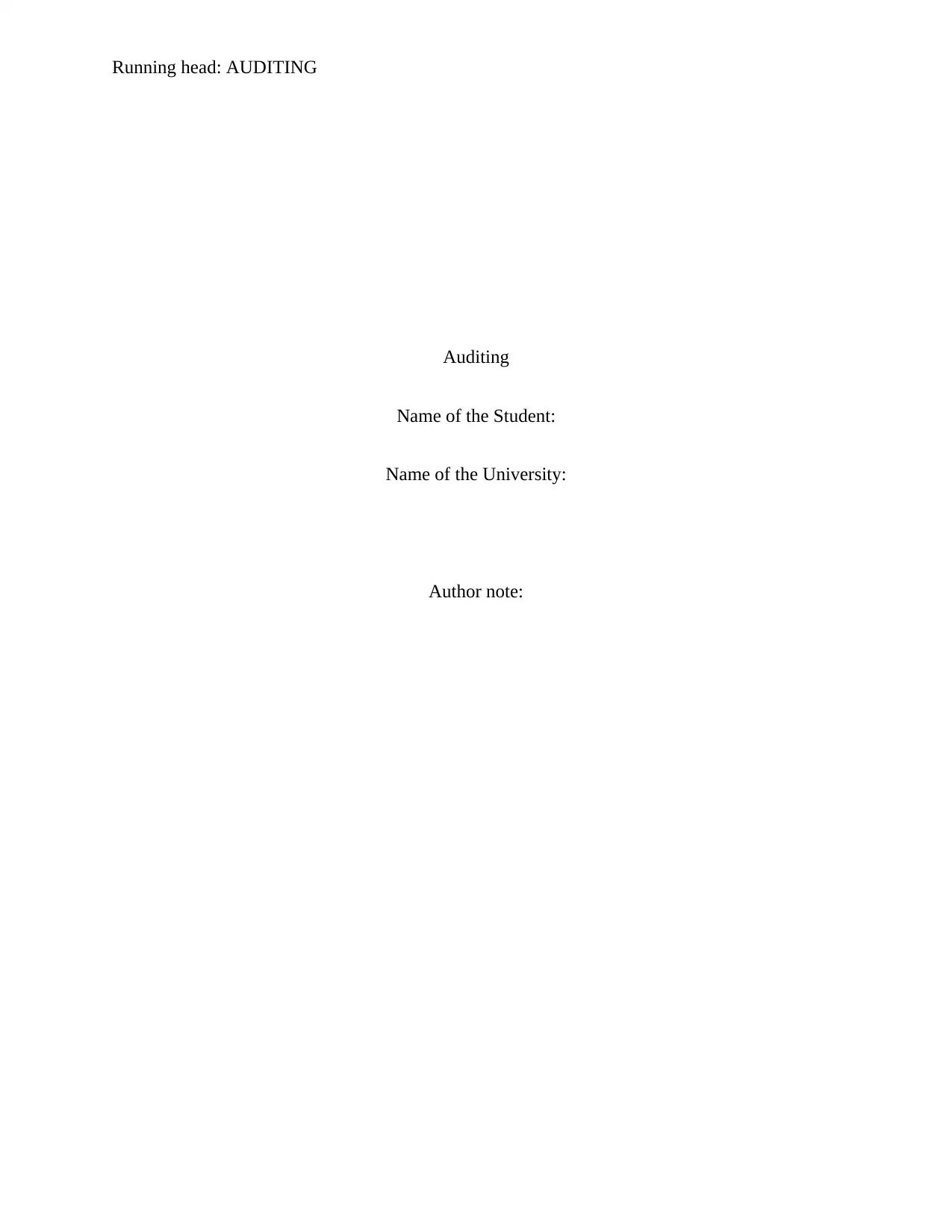
Running head: AUDITING
Auditing
Name of the Student:
Name of the University:
Author note:
Auditing
Name of the Student:
Name of the University:
Author note:
Paraphrase This Document
Need a fresh take? Get an instant paraphrase of this document with our AI Paraphraser
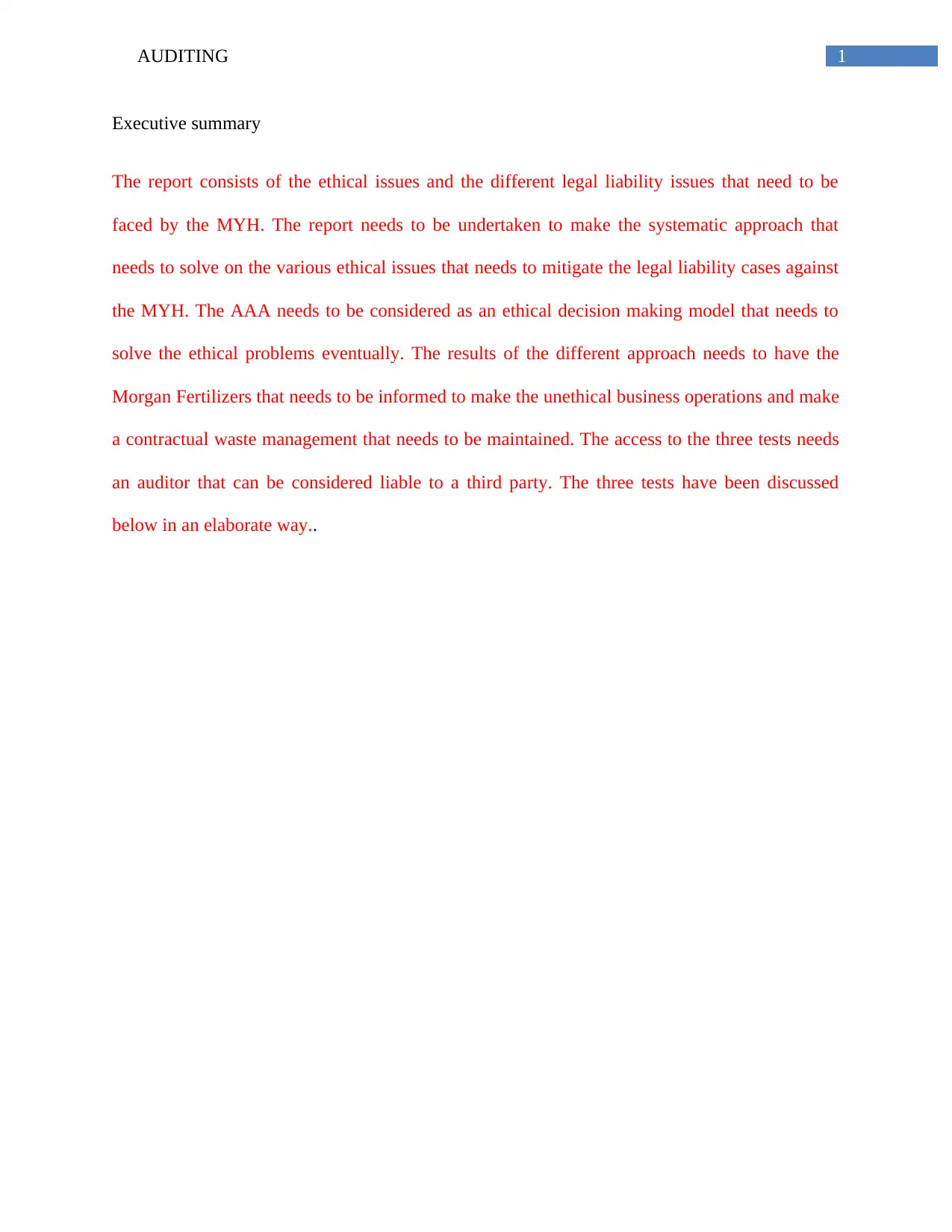
1AUDITING
Executive summary
The report consists of the ethical issues and the different legal liability issues that need to be
faced by the MYH. The report needs to be undertaken to make the systematic approach that
needs to solve on the various ethical issues that needs to mitigate the legal liability cases against
the MYH. The AAA needs to be considered as an ethical decision making model that needs to
solve the ethical problems eventually. The results of the different approach needs to have the
Morgan Fertilizers that needs to be informed to make the unethical business operations and make
a contractual waste management that needs to be maintained. The access to the three tests needs
an auditor that can be considered liable to a third party. The three tests have been discussed
below in an elaborate way..
Executive summary
The report consists of the ethical issues and the different legal liability issues that need to be
faced by the MYH. The report needs to be undertaken to make the systematic approach that
needs to solve on the various ethical issues that needs to mitigate the legal liability cases against
the MYH. The AAA needs to be considered as an ethical decision making model that needs to
solve the ethical problems eventually. The results of the different approach needs to have the
Morgan Fertilizers that needs to be informed to make the unethical business operations and make
a contractual waste management that needs to be maintained. The access to the three tests needs
an auditor that can be considered liable to a third party. The three tests have been discussed
below in an elaborate way..
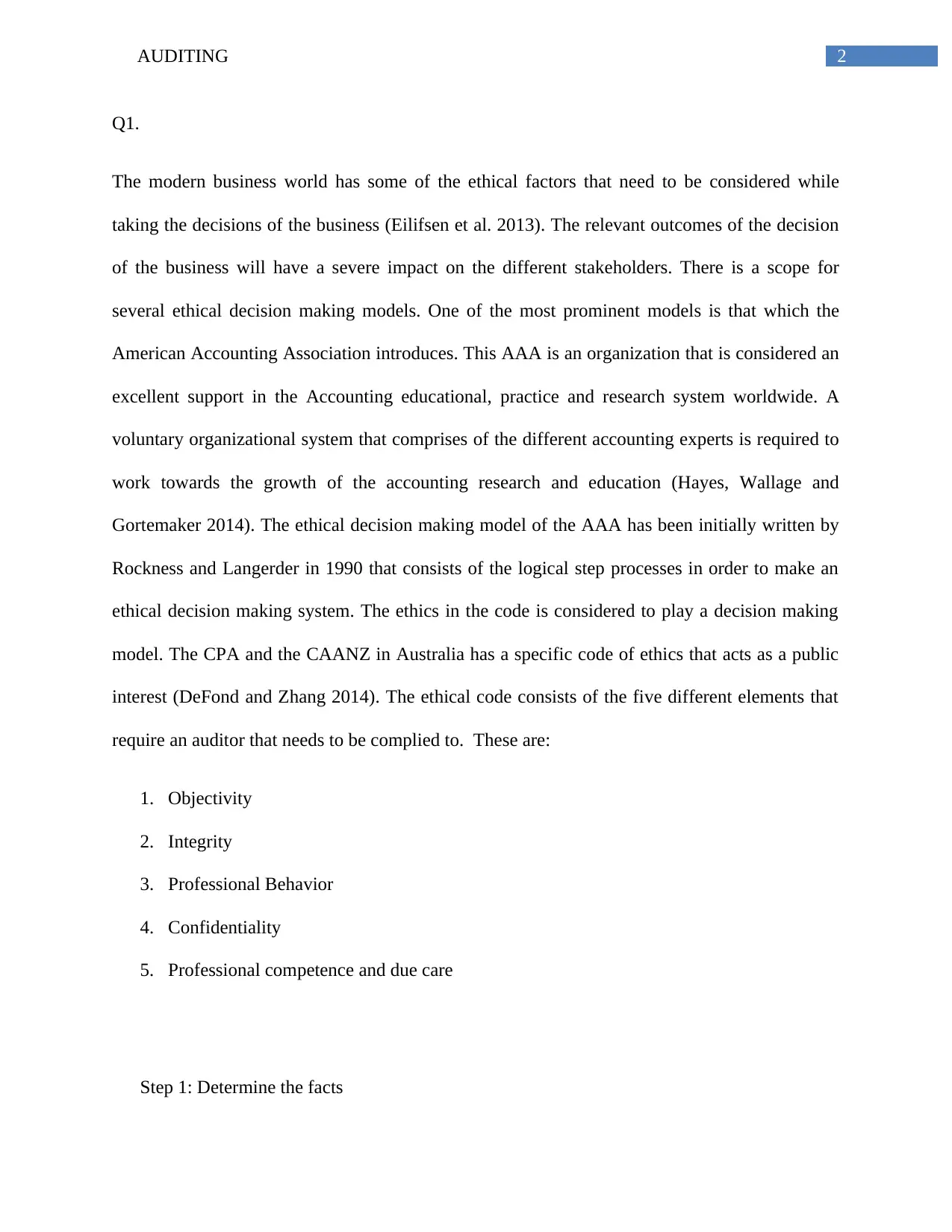
2AUDITING
Q1.
The modern business world has some of the ethical factors that need to be considered while
taking the decisions of the business (Eilifsen et al. 2013). The relevant outcomes of the decision
of the business will have a severe impact on the different stakeholders. There is a scope for
several ethical decision making models. One of the most prominent models is that which the
American Accounting Association introduces. This AAA is an organization that is considered an
excellent support in the Accounting educational, practice and research system worldwide. A
voluntary organizational system that comprises of the different accounting experts is required to
work towards the growth of the accounting research and education (Hayes, Wallage and
Gortemaker 2014). The ethical decision making model of the AAA has been initially written by
Rockness and Langerder in 1990 that consists of the logical step processes in order to make an
ethical decision making system. The ethics in the code is considered to play a decision making
model. The CPA and the CAANZ in Australia has a specific code of ethics that acts as a public
interest (DeFond and Zhang 2014). The ethical code consists of the five different elements that
require an auditor that needs to be complied to. These are:
1. Objectivity
2. Integrity
3. Professional Behavior
4. Confidentiality
5. Professional competence and due care
Step 1: Determine the facts
Q1.
The modern business world has some of the ethical factors that need to be considered while
taking the decisions of the business (Eilifsen et al. 2013). The relevant outcomes of the decision
of the business will have a severe impact on the different stakeholders. There is a scope for
several ethical decision making models. One of the most prominent models is that which the
American Accounting Association introduces. This AAA is an organization that is considered an
excellent support in the Accounting educational, practice and research system worldwide. A
voluntary organizational system that comprises of the different accounting experts is required to
work towards the growth of the accounting research and education (Hayes, Wallage and
Gortemaker 2014). The ethical decision making model of the AAA has been initially written by
Rockness and Langerder in 1990 that consists of the logical step processes in order to make an
ethical decision making system. The ethics in the code is considered to play a decision making
model. The CPA and the CAANZ in Australia has a specific code of ethics that acts as a public
interest (DeFond and Zhang 2014). The ethical code consists of the five different elements that
require an auditor that needs to be complied to. These are:
1. Objectivity
2. Integrity
3. Professional Behavior
4. Confidentiality
5. Professional competence and due care
Step 1: Determine the facts
⊘ This is a preview!⊘
Do you want full access?
Subscribe today to unlock all pages.

Trusted by 1+ million students worldwide
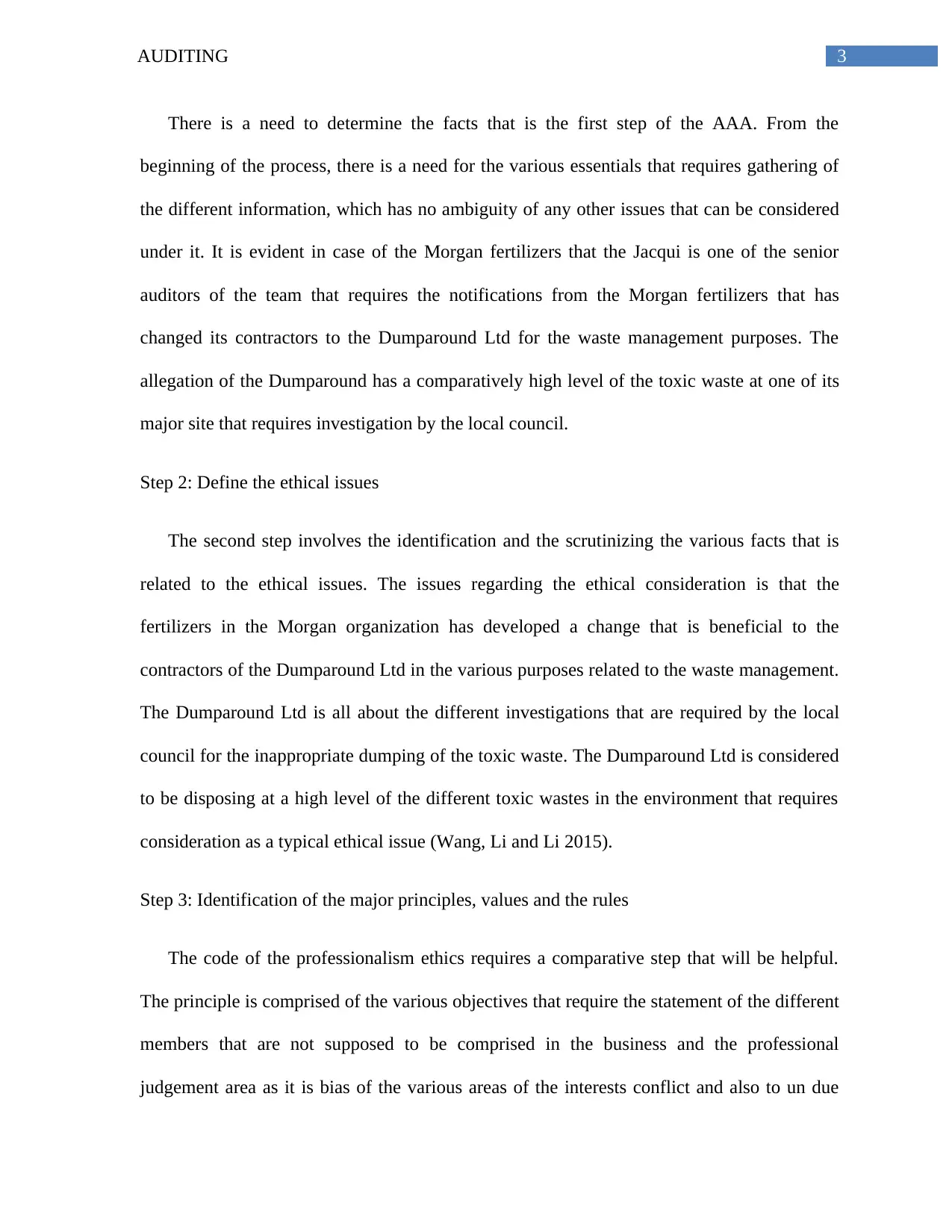
3AUDITING
There is a need to determine the facts that is the first step of the AAA. From the
beginning of the process, there is a need for the various essentials that requires gathering of
the different information, which has no ambiguity of any other issues that can be considered
under it. It is evident in case of the Morgan fertilizers that the Jacqui is one of the senior
auditors of the team that requires the notifications from the Morgan fertilizers that has
changed its contractors to the Dumparound Ltd for the waste management purposes. The
allegation of the Dumparound has a comparatively high level of the toxic waste at one of its
major site that requires investigation by the local council.
Step 2: Define the ethical issues
The second step involves the identification and the scrutinizing the various facts that is
related to the ethical issues. The issues regarding the ethical consideration is that the
fertilizers in the Morgan organization has developed a change that is beneficial to the
contractors of the Dumparound Ltd in the various purposes related to the waste management.
The Dumparound Ltd is all about the different investigations that are required by the local
council for the inappropriate dumping of the toxic waste. The Dumparound Ltd is considered
to be disposing at a high level of the different toxic wastes in the environment that requires
consideration as a typical ethical issue (Wang, Li and Li 2015).
Step 3: Identification of the major principles, values and the rules
The code of the professionalism ethics requires a comparative step that will be helpful.
The principle is comprised of the various objectives that require the statement of the different
members that are not supposed to be comprised in the business and the professional
judgement area as it is bias of the various areas of the interests conflict and also to un due
There is a need to determine the facts that is the first step of the AAA. From the
beginning of the process, there is a need for the various essentials that requires gathering of
the different information, which has no ambiguity of any other issues that can be considered
under it. It is evident in case of the Morgan fertilizers that the Jacqui is one of the senior
auditors of the team that requires the notifications from the Morgan fertilizers that has
changed its contractors to the Dumparound Ltd for the waste management purposes. The
allegation of the Dumparound has a comparatively high level of the toxic waste at one of its
major site that requires investigation by the local council.
Step 2: Define the ethical issues
The second step involves the identification and the scrutinizing the various facts that is
related to the ethical issues. The issues regarding the ethical consideration is that the
fertilizers in the Morgan organization has developed a change that is beneficial to the
contractors of the Dumparound Ltd in the various purposes related to the waste management.
The Dumparound Ltd is all about the different investigations that are required by the local
council for the inappropriate dumping of the toxic waste. The Dumparound Ltd is considered
to be disposing at a high level of the different toxic wastes in the environment that requires
consideration as a typical ethical issue (Wang, Li and Li 2015).
Step 3: Identification of the major principles, values and the rules
The code of the professionalism ethics requires a comparative step that will be helpful.
The principle is comprised of the various objectives that require the statement of the different
members that are not supposed to be comprised in the business and the professional
judgement area as it is bias of the various areas of the interests conflict and also to un due
Paraphrase This Document
Need a fresh take? Get an instant paraphrase of this document with our AI Paraphraser
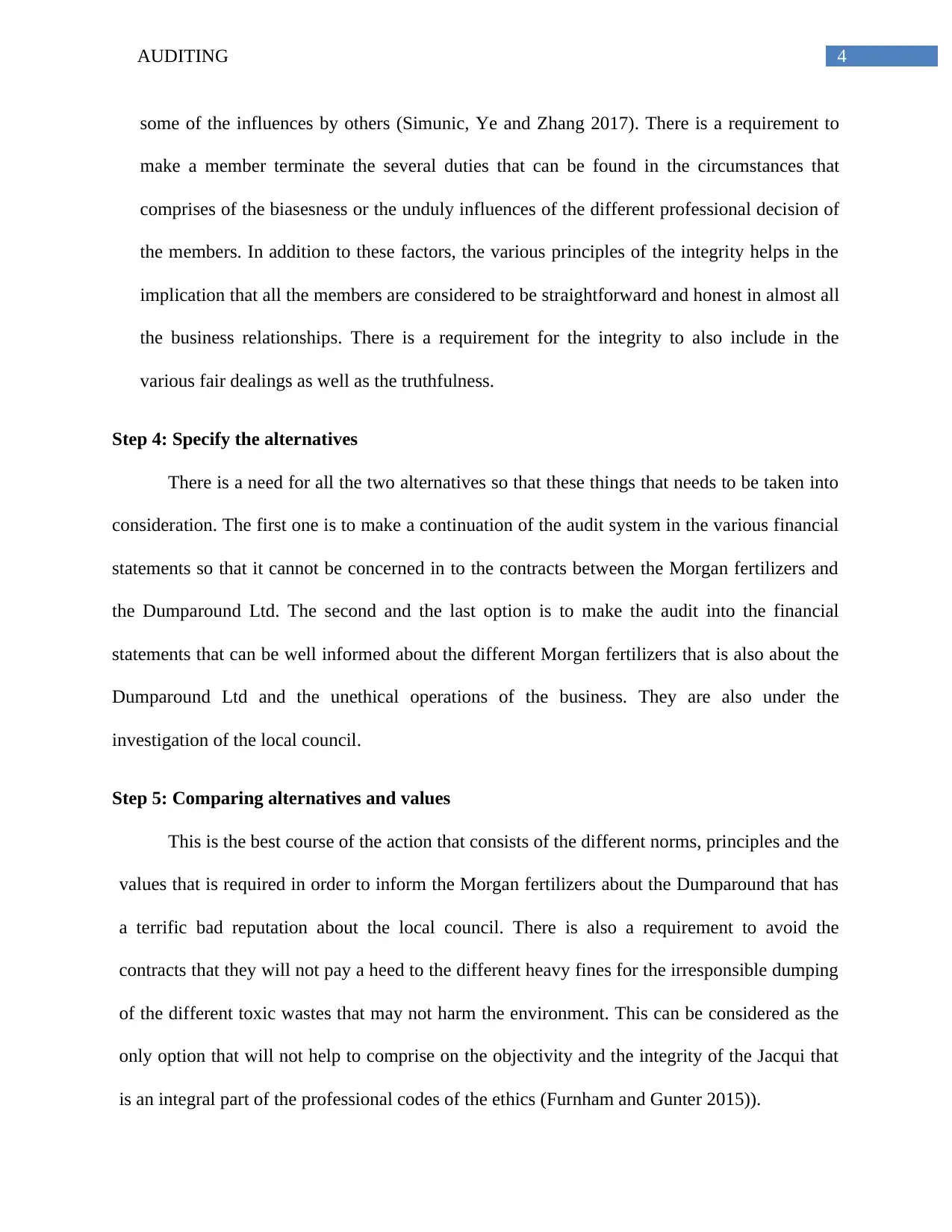
4AUDITING
some of the influences by others (Simunic, Ye and Zhang 2017). There is a requirement to
make a member terminate the several duties that can be found in the circumstances that
comprises of the biasesness or the unduly influences of the different professional decision of
the members. In addition to these factors, the various principles of the integrity helps in the
implication that all the members are considered to be straightforward and honest in almost all
the business relationships. There is a requirement for the integrity to also include in the
various fair dealings as well as the truthfulness.
Step 4: Specify the alternatives
There is a need for all the two alternatives so that these things that needs to be taken into
consideration. The first one is to make a continuation of the audit system in the various financial
statements so that it cannot be concerned in to the contracts between the Morgan fertilizers and
the Dumparound Ltd. The second and the last option is to make the audit into the financial
statements that can be well informed about the different Morgan fertilizers that is also about the
Dumparound Ltd and the unethical operations of the business. They are also under the
investigation of the local council.
Step 5: Comparing alternatives and values
This is the best course of the action that consists of the different norms, principles and the
values that is required in order to inform the Morgan fertilizers about the Dumparound that has
a terrific bad reputation about the local council. There is also a requirement to avoid the
contracts that they will not pay a heed to the different heavy fines for the irresponsible dumping
of the different toxic wastes that may not harm the environment. This can be considered as the
only option that will not help to comprise on the objectivity and the integrity of the Jacqui that
is an integral part of the professional codes of the ethics (Furnham and Gunter 2015)).
some of the influences by others (Simunic, Ye and Zhang 2017). There is a requirement to
make a member terminate the several duties that can be found in the circumstances that
comprises of the biasesness or the unduly influences of the different professional decision of
the members. In addition to these factors, the various principles of the integrity helps in the
implication that all the members are considered to be straightforward and honest in almost all
the business relationships. There is a requirement for the integrity to also include in the
various fair dealings as well as the truthfulness.
Step 4: Specify the alternatives
There is a need for all the two alternatives so that these things that needs to be taken into
consideration. The first one is to make a continuation of the audit system in the various financial
statements so that it cannot be concerned in to the contracts between the Morgan fertilizers and
the Dumparound Ltd. The second and the last option is to make the audit into the financial
statements that can be well informed about the different Morgan fertilizers that is also about the
Dumparound Ltd and the unethical operations of the business. They are also under the
investigation of the local council.
Step 5: Comparing alternatives and values
This is the best course of the action that consists of the different norms, principles and the
values that is required in order to inform the Morgan fertilizers about the Dumparound that has
a terrific bad reputation about the local council. There is also a requirement to avoid the
contracts that they will not pay a heed to the different heavy fines for the irresponsible dumping
of the different toxic wastes that may not harm the environment. This can be considered as the
only option that will not help to comprise on the objectivity and the integrity of the Jacqui that
is an integral part of the professional codes of the ethics (Furnham and Gunter 2015)).
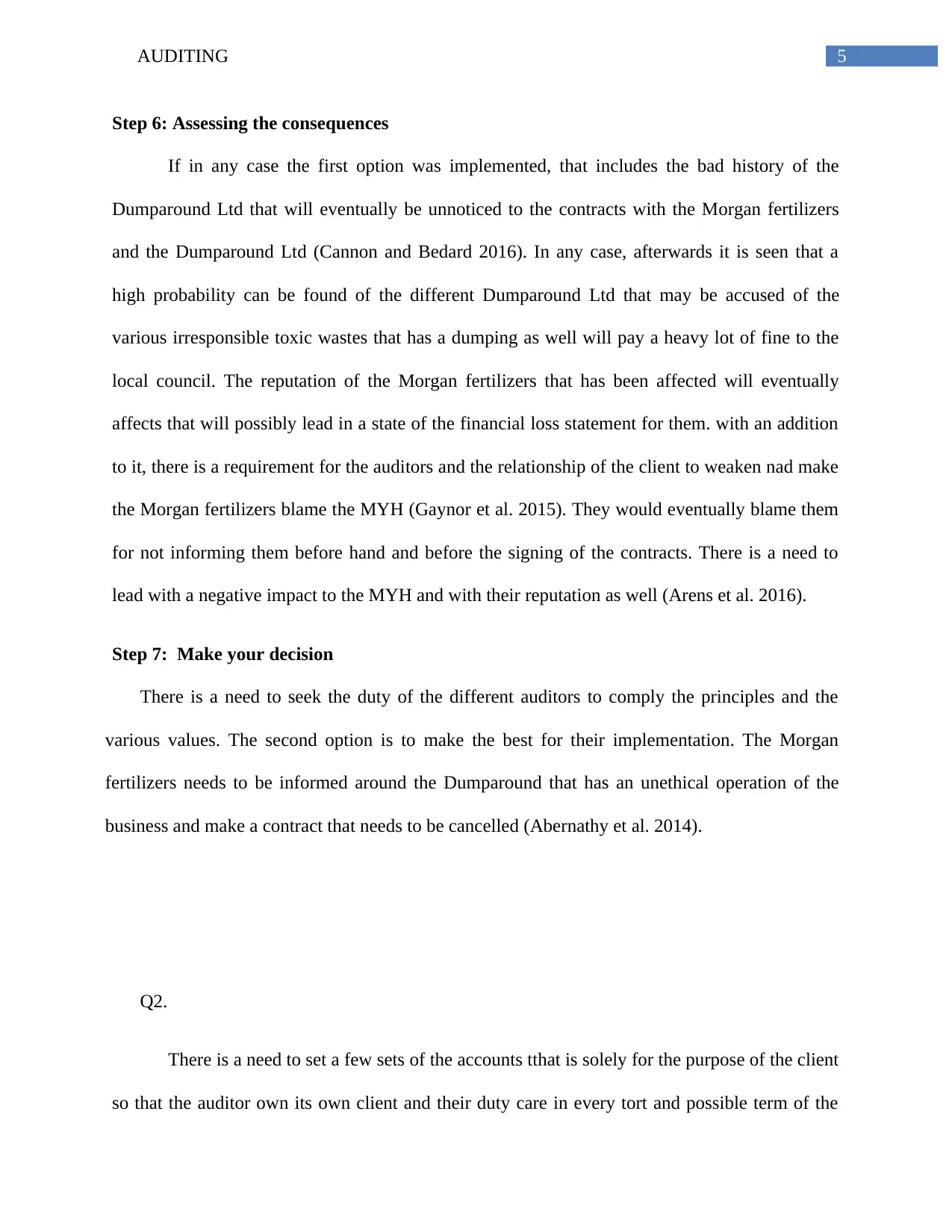
5AUDITING
Step 6: Assessing the consequences
If in any case the first option was implemented, that includes the bad history of the
Dumparound Ltd that will eventually be unnoticed to the contracts with the Morgan fertilizers
and the Dumparound Ltd (Cannon and Bedard 2016). In any case, afterwards it is seen that a
high probability can be found of the different Dumparound Ltd that may be accused of the
various irresponsible toxic wastes that has a dumping as well will pay a heavy lot of fine to the
local council. The reputation of the Morgan fertilizers that has been affected will eventually
affects that will possibly lead in a state of the financial loss statement for them. with an addition
to it, there is a requirement for the auditors and the relationship of the client to weaken nad make
the Morgan fertilizers blame the MYH (Gaynor et al. 2015). They would eventually blame them
for not informing them before hand and before the signing of the contracts. There is a need to
lead with a negative impact to the MYH and with their reputation as well (Arens et al. 2016).
Step 7: Make your decision
There is a need to seek the duty of the different auditors to comply the principles and the
various values. The second option is to make the best for their implementation. The Morgan
fertilizers needs to be informed around the Dumparound that has an unethical operation of the
business and make a contract that needs to be cancelled (Abernathy et al. 2014).
Q2.
There is a need to set a few sets of the accounts tthat is solely for the purpose of the client
so that the auditor own its own client and their duty care in every tort and possible term of the
Step 6: Assessing the consequences
If in any case the first option was implemented, that includes the bad history of the
Dumparound Ltd that will eventually be unnoticed to the contracts with the Morgan fertilizers
and the Dumparound Ltd (Cannon and Bedard 2016). In any case, afterwards it is seen that a
high probability can be found of the different Dumparound Ltd that may be accused of the
various irresponsible toxic wastes that has a dumping as well will pay a heavy lot of fine to the
local council. The reputation of the Morgan fertilizers that has been affected will eventually
affects that will possibly lead in a state of the financial loss statement for them. with an addition
to it, there is a requirement for the auditors and the relationship of the client to weaken nad make
the Morgan fertilizers blame the MYH (Gaynor et al. 2015). They would eventually blame them
for not informing them before hand and before the signing of the contracts. There is a need to
lead with a negative impact to the MYH and with their reputation as well (Arens et al. 2016).
Step 7: Make your decision
There is a need to seek the duty of the different auditors to comply the principles and the
various values. The second option is to make the best for their implementation. The Morgan
fertilizers needs to be informed around the Dumparound that has an unethical operation of the
business and make a contract that needs to be cancelled (Abernathy et al. 2014).
Q2.
There is a need to set a few sets of the accounts tthat is solely for the purpose of the client
so that the auditor own its own client and their duty care in every tort and possible term of the
⊘ This is a preview!⊘
Do you want full access?
Subscribe today to unlock all pages.

Trusted by 1+ million students worldwide
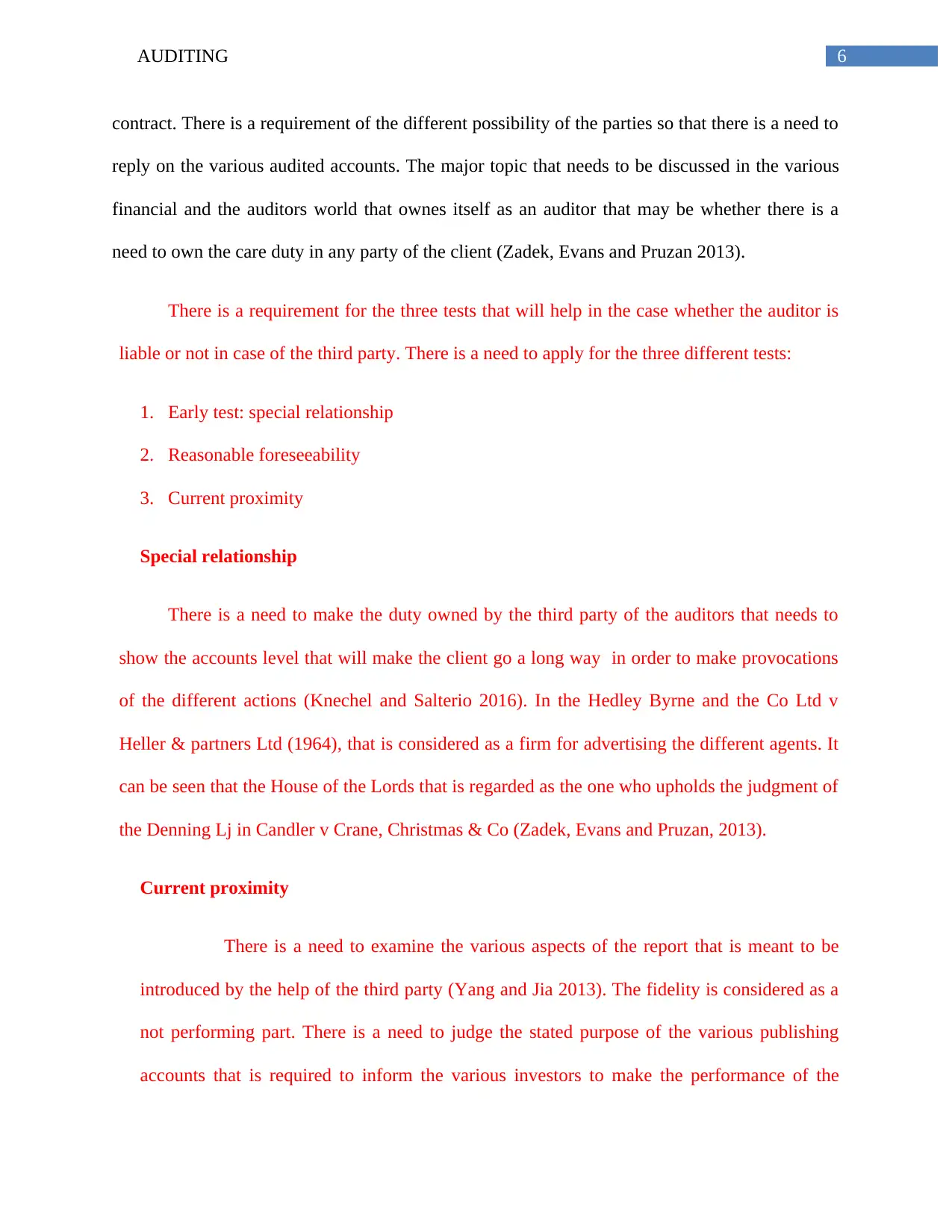
6AUDITING
contract. There is a requirement of the different possibility of the parties so that there is a need to
reply on the various audited accounts. The major topic that needs to be discussed in the various
financial and the auditors world that ownes itself as an auditor that may be whether there is a
need to own the care duty in any party of the client (Zadek, Evans and Pruzan 2013).
There is a requirement for the three tests that will help in the case whether the auditor is
liable or not in case of the third party. There is a need to apply for the three different tests:
1. Early test: special relationship
2. Reasonable foreseeability
3. Current proximity
Special relationship
There is a need to make the duty owned by the third party of the auditors that needs to
show the accounts level that will make the client go a long way in order to make provocations
of the different actions (Knechel and Salterio 2016). In the Hedley Byrne and the Co Ltd v
Heller & partners Ltd (1964), that is considered as a firm for advertising the different agents. It
can be seen that the House of the Lords that is regarded as the one who upholds the judgment of
the Denning Lj in Candler v Crane, Christmas & Co (Zadek, Evans and Pruzan, 2013).
Current proximity
There is a need to examine the various aspects of the report that is meant to be
introduced by the help of the third party (Yang and Jia 2013). The fidelity is considered as a
not performing part. There is a need to judge the stated purpose of the various publishing
accounts that is required to inform the various investors to make the performance of the
contract. There is a requirement of the different possibility of the parties so that there is a need to
reply on the various audited accounts. The major topic that needs to be discussed in the various
financial and the auditors world that ownes itself as an auditor that may be whether there is a
need to own the care duty in any party of the client (Zadek, Evans and Pruzan 2013).
There is a requirement for the three tests that will help in the case whether the auditor is
liable or not in case of the third party. There is a need to apply for the three different tests:
1. Early test: special relationship
2. Reasonable foreseeability
3. Current proximity
Special relationship
There is a need to make the duty owned by the third party of the auditors that needs to
show the accounts level that will make the client go a long way in order to make provocations
of the different actions (Knechel and Salterio 2016). In the Hedley Byrne and the Co Ltd v
Heller & partners Ltd (1964), that is considered as a firm for advertising the different agents. It
can be seen that the House of the Lords that is regarded as the one who upholds the judgment of
the Denning Lj in Candler v Crane, Christmas & Co (Zadek, Evans and Pruzan, 2013).
Current proximity
There is a need to examine the various aspects of the report that is meant to be
introduced by the help of the third party (Yang and Jia 2013). The fidelity is considered as a
not performing part. There is a need to judge the stated purpose of the various publishing
accounts that is required to inform the various investors to make the performance of the
Paraphrase This Document
Need a fresh take? Get an instant paraphrase of this document with our AI Paraphraser
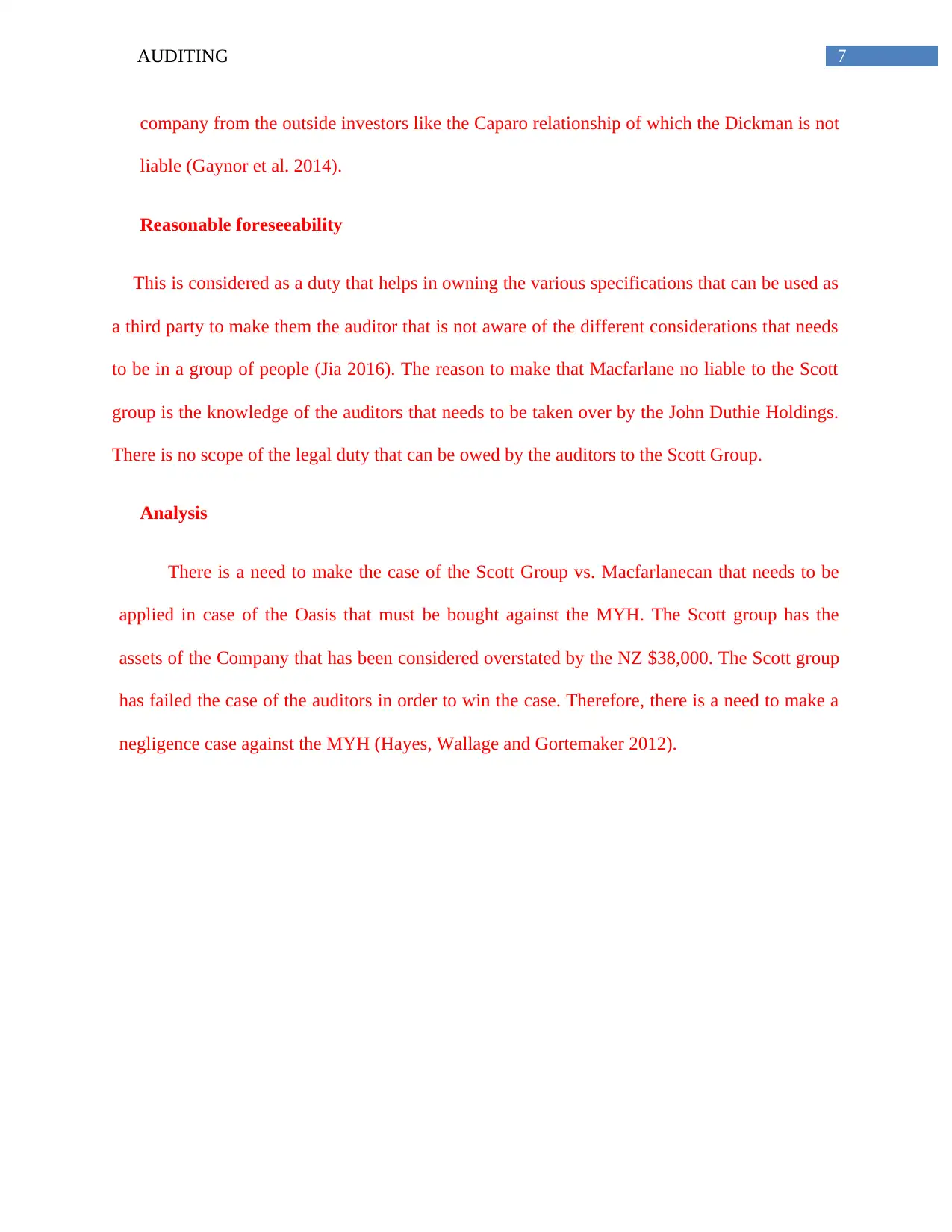
7AUDITING
company from the outside investors like the Caparo relationship of which the Dickman is not
liable (Gaynor et al. 2014).
Reasonable foreseeability
This is considered as a duty that helps in owning the various specifications that can be used as
a third party to make them the auditor that is not aware of the different considerations that needs
to be in a group of people (Jia 2016). The reason to make that Macfarlane no liable to the Scott
group is the knowledge of the auditors that needs to be taken over by the John Duthie Holdings.
There is no scope of the legal duty that can be owed by the auditors to the Scott Group.
Analysis
There is a need to make the case of the Scott Group vs. Macfarlanecan that needs to be
applied in case of the Oasis that must be bought against the MYH. The Scott group has the
assets of the Company that has been considered overstated by the NZ $38,000. The Scott group
has failed the case of the auditors in order to win the case. Therefore, there is a need to make a
negligence case against the MYH (Hayes, Wallage and Gortemaker 2012).
company from the outside investors like the Caparo relationship of which the Dickman is not
liable (Gaynor et al. 2014).
Reasonable foreseeability
This is considered as a duty that helps in owning the various specifications that can be used as
a third party to make them the auditor that is not aware of the different considerations that needs
to be in a group of people (Jia 2016). The reason to make that Macfarlane no liable to the Scott
group is the knowledge of the auditors that needs to be taken over by the John Duthie Holdings.
There is no scope of the legal duty that can be owed by the auditors to the Scott Group.
Analysis
There is a need to make the case of the Scott Group vs. Macfarlanecan that needs to be
applied in case of the Oasis that must be bought against the MYH. The Scott group has the
assets of the Company that has been considered overstated by the NZ $38,000. The Scott group
has failed the case of the auditors in order to win the case. Therefore, there is a need to make a
negligence case against the MYH (Hayes, Wallage and Gortemaker 2012).
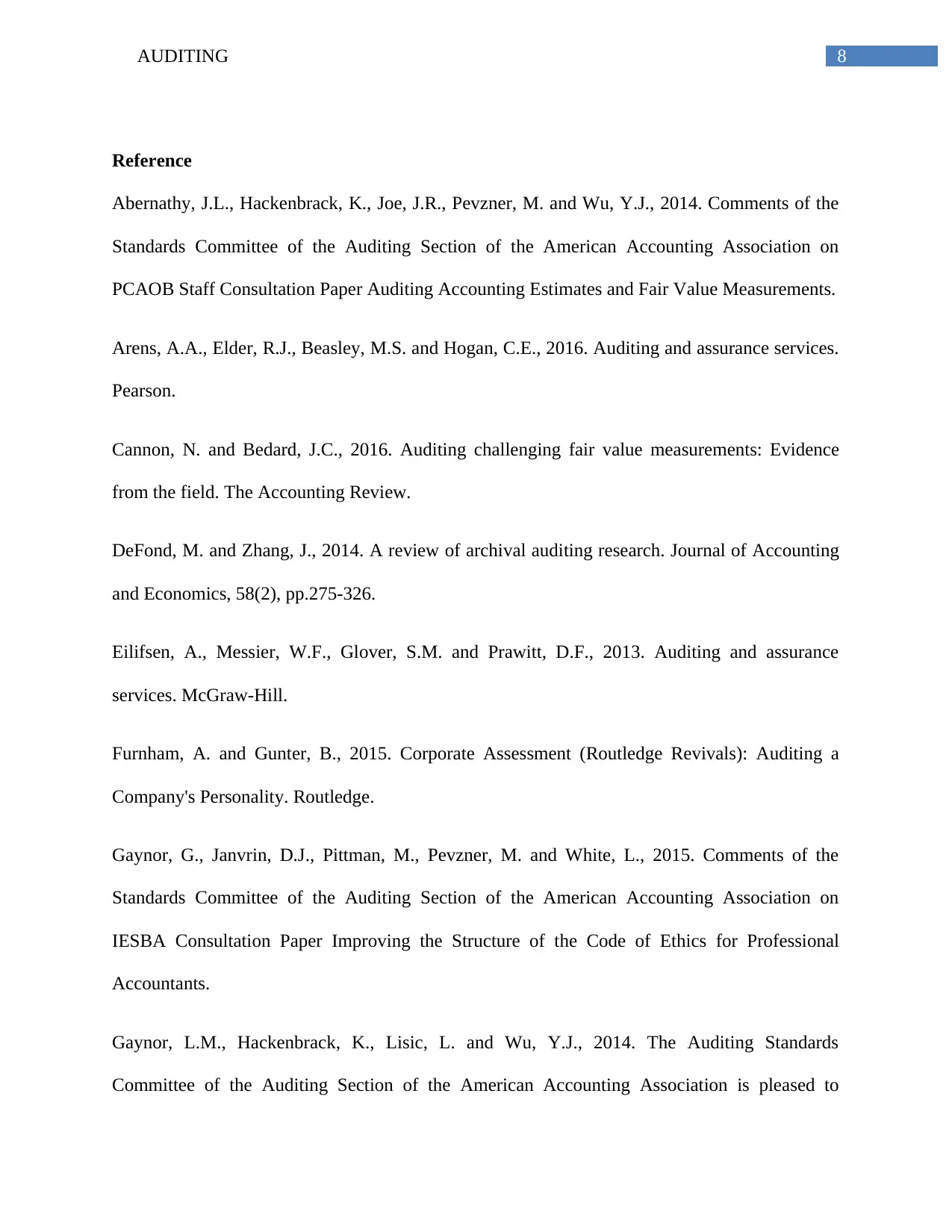
8AUDITING
Reference
Abernathy, J.L., Hackenbrack, K., Joe, J.R., Pevzner, M. and Wu, Y.J., 2014. Comments of the
Standards Committee of the Auditing Section of the American Accounting Association on
PCAOB Staff Consultation Paper Auditing Accounting Estimates and Fair Value Measurements.
Arens, A.A., Elder, R.J., Beasley, M.S. and Hogan, C.E., 2016. Auditing and assurance services.
Pearson.
Cannon, N. and Bedard, J.C., 2016. Auditing challenging fair value measurements: Evidence
from the field. The Accounting Review.
DeFond, M. and Zhang, J., 2014. A review of archival auditing research. Journal of Accounting
and Economics, 58(2), pp.275-326.
Eilifsen, A., Messier, W.F., Glover, S.M. and Prawitt, D.F., 2013. Auditing and assurance
services. McGraw-Hill.
Furnham, A. and Gunter, B., 2015. Corporate Assessment (Routledge Revivals): Auditing a
Company's Personality. Routledge.
Gaynor, G., Janvrin, D.J., Pittman, M., Pevzner, M. and White, L., 2015. Comments of the
Standards Committee of the Auditing Section of the American Accounting Association on
IESBA Consultation Paper Improving the Structure of the Code of Ethics for Professional
Accountants.
Gaynor, L.M., Hackenbrack, K., Lisic, L. and Wu, Y.J., 2014. The Auditing Standards
Committee of the Auditing Section of the American Accounting Association is pleased to
Reference
Abernathy, J.L., Hackenbrack, K., Joe, J.R., Pevzner, M. and Wu, Y.J., 2014. Comments of the
Standards Committee of the Auditing Section of the American Accounting Association on
PCAOB Staff Consultation Paper Auditing Accounting Estimates and Fair Value Measurements.
Arens, A.A., Elder, R.J., Beasley, M.S. and Hogan, C.E., 2016. Auditing and assurance services.
Pearson.
Cannon, N. and Bedard, J.C., 2016. Auditing challenging fair value measurements: Evidence
from the field. The Accounting Review.
DeFond, M. and Zhang, J., 2014. A review of archival auditing research. Journal of Accounting
and Economics, 58(2), pp.275-326.
Eilifsen, A., Messier, W.F., Glover, S.M. and Prawitt, D.F., 2013. Auditing and assurance
services. McGraw-Hill.
Furnham, A. and Gunter, B., 2015. Corporate Assessment (Routledge Revivals): Auditing a
Company's Personality. Routledge.
Gaynor, G., Janvrin, D.J., Pittman, M., Pevzner, M. and White, L., 2015. Comments of the
Standards Committee of the Auditing Section of the American Accounting Association on
IESBA Consultation Paper Improving the Structure of the Code of Ethics for Professional
Accountants.
Gaynor, L.M., Hackenbrack, K., Lisic, L. and Wu, Y.J., 2014. The Auditing Standards
Committee of the Auditing Section of the American Accounting Association is pleased to
⊘ This is a preview!⊘
Do you want full access?
Subscribe today to unlock all pages.

Trusted by 1+ million students worldwide
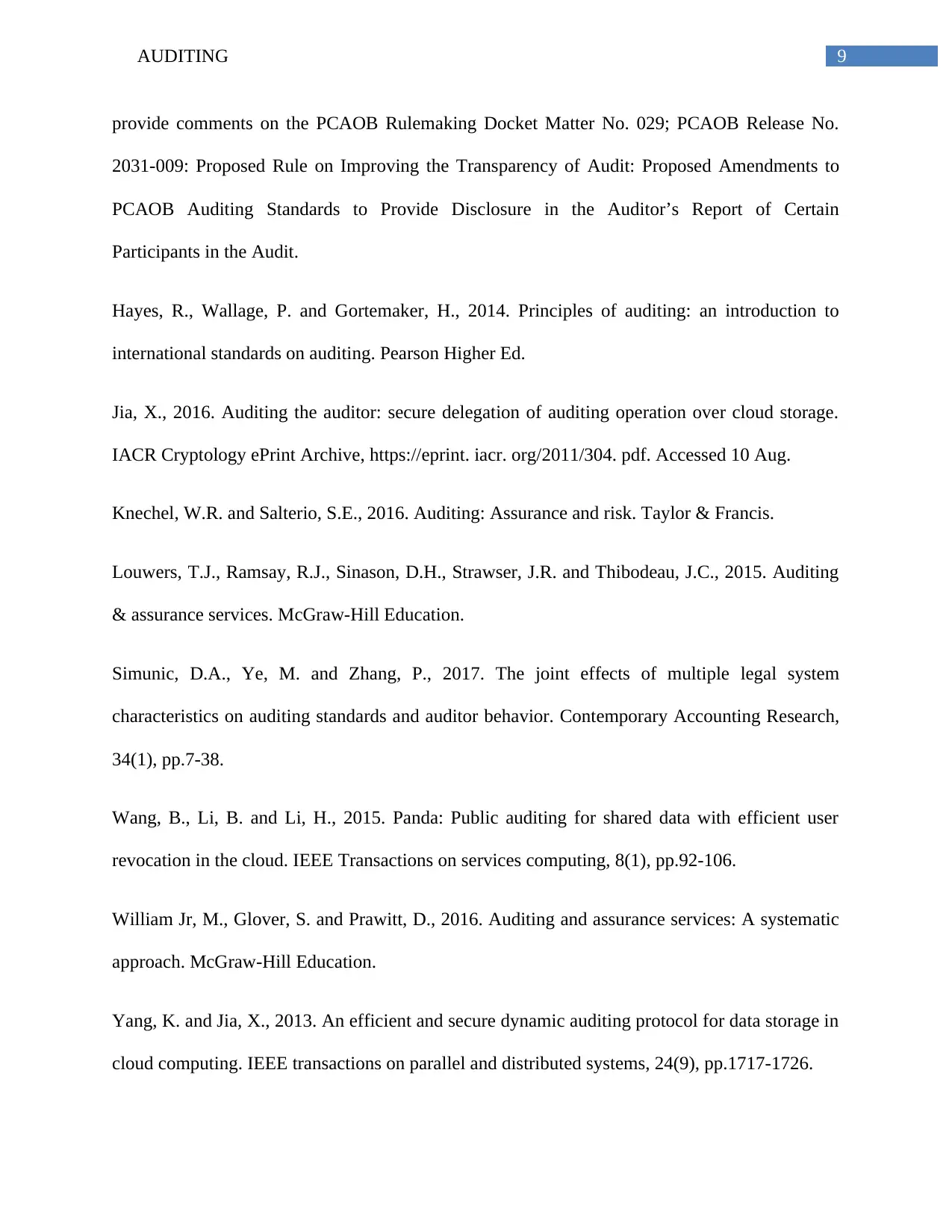
9AUDITING
provide comments on the PCAOB Rulemaking Docket Matter No. 029; PCAOB Release No.
2031-009: Proposed Rule on Improving the Transparency of Audit: Proposed Amendments to
PCAOB Auditing Standards to Provide Disclosure in the Auditor’s Report of Certain
Participants in the Audit.
Hayes, R., Wallage, P. and Gortemaker, H., 2014. Principles of auditing: an introduction to
international standards on auditing. Pearson Higher Ed.
Jia, X., 2016. Auditing the auditor: secure delegation of auditing operation over cloud storage.
IACR Cryptology ePrint Archive, https://eprint. iacr. org/2011/304. pdf. Accessed 10 Aug.
Knechel, W.R. and Salterio, S.E., 2016. Auditing: Assurance and risk. Taylor & Francis.
Louwers, T.J., Ramsay, R.J., Sinason, D.H., Strawser, J.R. and Thibodeau, J.C., 2015. Auditing
& assurance services. McGraw-Hill Education.
Simunic, D.A., Ye, M. and Zhang, P., 2017. The joint effects of multiple legal system
characteristics on auditing standards and auditor behavior. Contemporary Accounting Research,
34(1), pp.7-38.
Wang, B., Li, B. and Li, H., 2015. Panda: Public auditing for shared data with efficient user
revocation in the cloud. IEEE Transactions on services computing, 8(1), pp.92-106.
William Jr, M., Glover, S. and Prawitt, D., 2016. Auditing and assurance services: A systematic
approach. McGraw-Hill Education.
Yang, K. and Jia, X., 2013. An efficient and secure dynamic auditing protocol for data storage in
cloud computing. IEEE transactions on parallel and distributed systems, 24(9), pp.1717-1726.
provide comments on the PCAOB Rulemaking Docket Matter No. 029; PCAOB Release No.
2031-009: Proposed Rule on Improving the Transparency of Audit: Proposed Amendments to
PCAOB Auditing Standards to Provide Disclosure in the Auditor’s Report of Certain
Participants in the Audit.
Hayes, R., Wallage, P. and Gortemaker, H., 2014. Principles of auditing: an introduction to
international standards on auditing. Pearson Higher Ed.
Jia, X., 2016. Auditing the auditor: secure delegation of auditing operation over cloud storage.
IACR Cryptology ePrint Archive, https://eprint. iacr. org/2011/304. pdf. Accessed 10 Aug.
Knechel, W.R. and Salterio, S.E., 2016. Auditing: Assurance and risk. Taylor & Francis.
Louwers, T.J., Ramsay, R.J., Sinason, D.H., Strawser, J.R. and Thibodeau, J.C., 2015. Auditing
& assurance services. McGraw-Hill Education.
Simunic, D.A., Ye, M. and Zhang, P., 2017. The joint effects of multiple legal system
characteristics on auditing standards and auditor behavior. Contemporary Accounting Research,
34(1), pp.7-38.
Wang, B., Li, B. and Li, H., 2015. Panda: Public auditing for shared data with efficient user
revocation in the cloud. IEEE Transactions on services computing, 8(1), pp.92-106.
William Jr, M., Glover, S. and Prawitt, D., 2016. Auditing and assurance services: A systematic
approach. McGraw-Hill Education.
Yang, K. and Jia, X., 2013. An efficient and secure dynamic auditing protocol for data storage in
cloud computing. IEEE transactions on parallel and distributed systems, 24(9), pp.1717-1726.
Paraphrase This Document
Need a fresh take? Get an instant paraphrase of this document with our AI Paraphraser
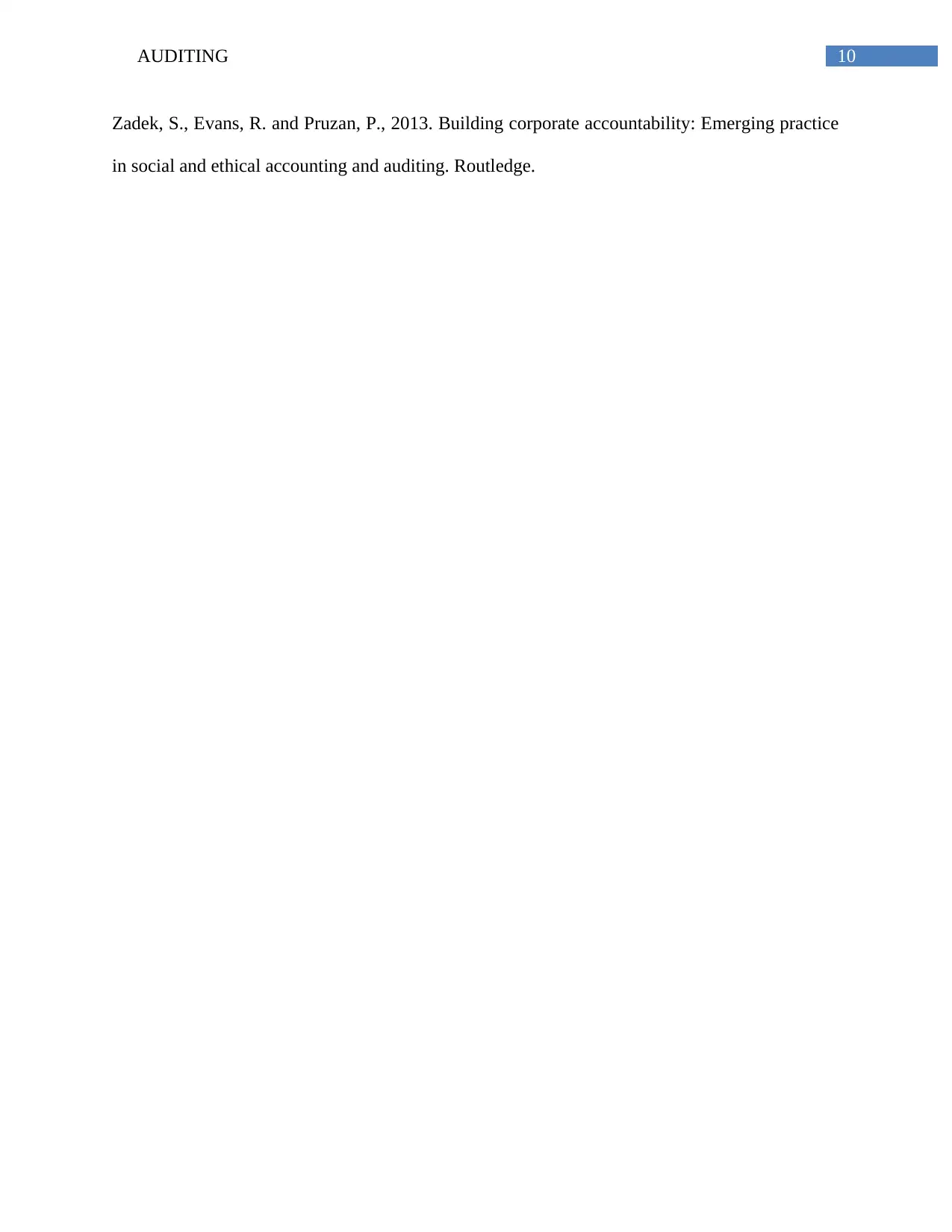
10AUDITING
Zadek, S., Evans, R. and Pruzan, P., 2013. Building corporate accountability: Emerging practice
in social and ethical accounting and auditing. Routledge.
Zadek, S., Evans, R. and Pruzan, P., 2013. Building corporate accountability: Emerging practice
in social and ethical accounting and auditing. Routledge.
1 out of 11
Related Documents
Your All-in-One AI-Powered Toolkit for Academic Success.
+13062052269
info@desklib.com
Available 24*7 on WhatsApp / Email
![[object Object]](/_next/static/media/star-bottom.7253800d.svg)
Unlock your academic potential
Copyright © 2020–2025 A2Z Services. All Rights Reserved. Developed and managed by ZUCOL.





